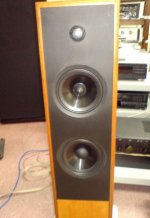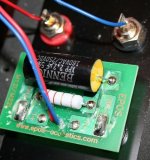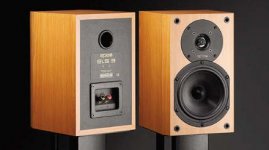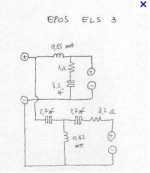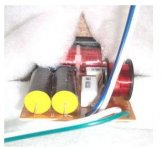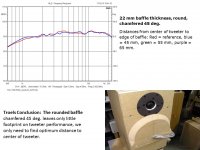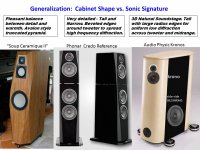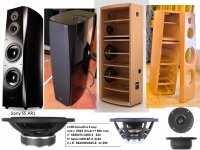Hi fanatics,
Having read and enjoyed a portion of the epic Giuseppe D'Appolito MTM 'Thor' thread, I hesitated more than once before registering, and hesitated again before posting this thread. My knowledge of Audio Physics extends to how to put 30 yr. old Naim connectors into their respective sockets - but I can make cabinets.
Can anyone reassure me that if I set out on an Ekta Mk11 build, there's a good chance that they will please me as much as, if not more than, my 30 yr old Epos es 22s? Are they an appropriate choice for my current amplification? i note that the DTQWTs can be built for a similar cost, but maybe they're less of a match to my system.
Naim 72 pre with Avondale Audio Audiophile 831 mod.
Avondale upgraded Hi Cap P.S.
Graham Slee Reflex M phono
Avondale Audio s100 80W(+/-)
Graham Slee Spatia speaker cables
Having read and enjoyed a portion of the epic Giuseppe D'Appolito MTM 'Thor' thread, I hesitated more than once before registering, and hesitated again before posting this thread. My knowledge of Audio Physics extends to how to put 30 yr. old Naim connectors into their respective sockets - but I can make cabinets.
Can anyone reassure me that if I set out on an Ekta Mk11 build, there's a good chance that they will please me as much as, if not more than, my 30 yr old Epos es 22s? Are they an appropriate choice for my current amplification? i note that the DTQWTs can be built for a similar cost, but maybe they're less of a match to my system.
Naim 72 pre with Avondale Audio Audiophile 831 mod.
Avondale upgraded Hi Cap P.S.
Graham Slee Reflex M phono
Avondale Audio s100 80W(+/-)
Graham Slee Spatia speaker cables
Last edited:
From the datasheet, the design philosophy behind your Epos ES22 speakers seems "odd" by today's design knowledge.
1) The tweeter uses only 1-capacitor for the crossover, and the tweeter is located several inches above the midrange on the front baffle such that lobbing will occur.
2) The 6" poly-plastic cone midrange is run full range with no crossover components.
3) The 6" poly-plastic cone woofer uses a single inductor for the crossover.
I would not expect "audiophile grade" sound from this design.
The EKTA II uses some of the absolute best drivers in production, with time and phase adjusted crossovers. (Drivers: 7" woofer 18WU/4741T00 4" midrange 12MU/8731T00 1" dome tweeter D2608/913000) The drivers use slit-paper cones to reduce resonances. Very low Le motors for wide&flat bandwidth. Open chassis frames to allow clean unobstructed air flow. The 4" midrange 12MU/8731T00 has proven to deliver great detail with a very natural tone. The 7" woofer 18WU/4741T00 will produce CLEAN, CLEAN, CLEAN bass with -F3 = 40Hz before room gain. Properly constructed, I would expect "audiophile grade" sound from this design.
If you desire more powerful mids and deeper bass, Troels SB10 design uses a larger cabinet to hold a 5.5" midrange and 10" woofer( SB29NRX75-6 delivers -F3=28Hz in ported 55l volume). How large is your room? There are a few other SB-Acoustics Satori MR13P and MR16P midrange drivers based free diy designs with excellent sound reasonable prices.
SBAcoustics 10
1) The tweeter uses only 1-capacitor for the crossover, and the tweeter is located several inches above the midrange on the front baffle such that lobbing will occur.
2) The 6" poly-plastic cone midrange is run full range with no crossover components.
3) The 6" poly-plastic cone woofer uses a single inductor for the crossover.
I would not expect "audiophile grade" sound from this design.
The EKTA II uses some of the absolute best drivers in production, with time and phase adjusted crossovers. (Drivers: 7" woofer 18WU/4741T00 4" midrange 12MU/8731T00 1" dome tweeter D2608/913000) The drivers use slit-paper cones to reduce resonances. Very low Le motors for wide&flat bandwidth. Open chassis frames to allow clean unobstructed air flow. The 4" midrange 12MU/8731T00 has proven to deliver great detail with a very natural tone. The 7" woofer 18WU/4741T00 will produce CLEAN, CLEAN, CLEAN bass with -F3 = 40Hz before room gain. Properly constructed, I would expect "audiophile grade" sound from this design.
If you desire more powerful mids and deeper bass, Troels SB10 design uses a larger cabinet to hold a 5.5" midrange and 10" woofer( SB29NRX75-6 delivers -F3=28Hz in ported 55l volume). How large is your room? There are a few other SB-Acoustics Satori MR13P and MR16P midrange drivers based free diy designs with excellent sound reasonable prices.
SBAcoustics 10
Hi Line Source
Really good of you to get back and for being so informative. I'm very reassured! Yes, Robin Marshall claimed it was all about the design of the drivers, but that was then ... and your summing up of his design made me chuckle.
Sounds like I should just get on with it then, but FWIW my room is almost square, unfortunately, about 5 x 5 metres and 2.7m to a heavily beamed ceiling. It does have quite wide doors (one set between the speakers) that are invariably open at both ends. No problem to have speakers up to 60cm away from front wall and well away from the corners as well.
There's an earlier, very positive mention of the SBA 10, albeit the member was critical of some aspects of other TG designs.
Really good of you to get back and for being so informative. I'm very reassured! Yes, Robin Marshall claimed it was all about the design of the drivers, but that was then ... and your summing up of his design made me chuckle.
Sounds like I should just get on with it then, but FWIW my room is almost square, unfortunately, about 5 x 5 metres and 2.7m to a heavily beamed ceiling. It does have quite wide doors (one set between the speakers) that are invariably open at both ends. No problem to have speakers up to 60cm away from front wall and well away from the corners as well.
There's an earlier, very positive mention of the SBA 10, albeit the member was critical of some aspects of other TG designs.
...I meant to add that, re your reference to other diy MR Satori based designs, these would have to include cabinet design for me to be able to work with them. I've noticed that Selah Audio do an interesting 1,700 dollar Satori kit called the "Essenza" with dual 7.5" woofers a 5" mid and Be tweeter - seems a lot of drivers for the money. Price wise this is not so far off the Ekta, but the Selah website doesn't compare with the wonderfully transparent and informative TG site - there's nothing about crossover/cabinet design etc. that might indicate this design's particular virtues - musicality, delicacy and detail more important to me than how loud they go...
Last edited:
This is highly subjective, you can't buy a speaker based on a write up. If you need to audition before buying, you need to opt for commercial offerings. I still think that the used market offers real savings and permits to resell without (significant) loss.musicality, delicacy and detail
Having said that a kit from some competent designer using good value drivers should not disappoint. In this respect IMHO I find the old TG designs a good source of inspiration but think that a more competent designer could have done better on some of them. Moreover recently he found the holy grail in the LR2 slopes with stepped baffle. He is doing a redesign of old speakers with the stepped baffle approach and those new designs aren't open anymore, you have to buy a kit. And I don't ever want to talk about his choice of crossover components.
If I were to buy a kit with the Satori drivers, I'd buy the Kairos, it can even be modified to a 3-way if you need to (see here: https://app.box.com/s/a4bqr447s7ox7v9kt7r9tjui0h7yqkrv).
If you feel that a 10" driver is too much for your room (25sqm isn't a big room), and a 8" woofer would be better I think that the TG 3w-classic is a good value speaker: SEAS-3-Way-Classic
Ralf
If you buy a kit there should be a detailed plan for the cabinets, sometimes you will have it before buying, but I wouldn't build anything without the drivers in hand (it's all about tolerances, if you route a rebate too small or big, it is a pain to correct it).
Having said that a kit from some competent designer using good value drivers should not disappoint. In this respect IMHO I find the old TG designs a good source of inspiration.
Thanks for such a perceptive and very helpful response re the TG kits and some alternatives. The issue for me is my cabinet making skills far exceed my knowledge of electronics, not to mention audio physics, so a kit, closed or otherwise (I'm bitten by this bug) it will probably have to be.
Are you saying that the stepped baffle, in the case of the TG Ekta, is sonically a step backwards from the earlier model, or is your point more to do with a move a way from designs that can be adapted, explored, modified? From my point of view, the stepped baffle poses a bit of an aesthetic challenge - it's a bit harder to get the speakers looking good compared to a flat baffle. However, I'm also very interested in your critical comments about this and the "holy grail of LR2", but maybe it's above my head - a steep learning curve (or is it slope?)
Anyway, I'm hanging on to your main point re competent designers and decent drive units and thanks for all of your excellent advice and suggestions!
The problem is that the Ekta mkII has nothing in common to the original Ekta, so comparing them is pointless, it seems only a marketing thing in order to buy the whole kit for which obviously TG receives a fee. I don't have a problem with this, but you can't even find the original design in the TG site, even if it is there, you have to use google, and that disturbs me.
What I don't like in the TG stepped baffle approach, is that I don't see any word on how to address the obvious diffraction problem that the step has.
To your original question, I wouldn't worry about speaker-amp match, as a decent solid state amp should drive every speaker. I would worry about a speaker-room match, and I think that the DTQWT is way too big for yours.
Ralf
What I don't like in the TG stepped baffle approach, is that I don't see any word on how to address the obvious diffraction problem that the step has.
To your original question, I wouldn't worry about speaker-amp match, as a decent solid state amp should drive every speaker. I would worry about a speaker-room match, and I think that the DTQWT is way too big for yours.
Ralf
What I don't like in the TG stepped baffle approach...
Okay, the diffraction issue is a really helpful pointer for me to pursue, perhaps with TG himself. Really helpful point about the DTQWT as well - that's one less bit of thinking to do - thanks!
Paul
PS I've just found an article by TG that appears to have addressed the issue, satisfactorily? Unfortunately, the URL gets a 401 when I type it, so I can't send you the link. I just googled Troels Gravesen stepped baffle diffraction issues
Okay, the diffraction issue is a really helpful pointer for me to pursue, perhaps with TG himself. Really helpful point about the DTQWT as well - that's one less bit of thinking to do - thanks!
Paul
PS I've just found an article by TG that appears to have addressed the issue, satisfactorily? Unfortunately, the URL gets a 401 when I type it, so I can't send you the link. I just googled Troels Gravesen stepped baffle diffraction issues
Last edited:
tweeter located several inches from the mid range and lobing will occur
- probably not of interest, but re comments by LineSource on the old Epos and lobing, the distance between the Epos tweeter and mid centres is only 10 mm more than that of the Ekta Mk11 tweeter and mid.
- probably not of interest, but re comments by LineSource on the old Epos and lobing, the distance between the Epos tweeter and mid centres is only 10 mm more than that of the Ekta Mk11 tweeter and mid.
lupo 1, you are right. We ARE fanatics. Here is your ES22 (below) for reference. 
Epos is a tremendously interesting company. Now owned by Michael Creek rather than Robin Marshall.
I'm not sure I actually agree with Robin Marshall on everything, but I listen to his ideas. What he did tremendously well, was build well-behaved polycone bass units that needed little filtering to work well. One of my earliest speakers was the Mordaunt Short MS10i, which bore a close resemblance to this Epos ELS-3 design.
I think you can see the pedigree. Robin tended to use very simplistic filters, as in the famous two way Epos M12i. A mere 2.2uF capacitor plus a slightly mysterious 47R resistor on the tweeter.
As it goes, Michael Creek tends to use more complex, steeper filters these days with the same well-behaved drive units. Which to me, means they go louder with less distortion.
All a trade-off. Who knows who is right?
But, as a hobbyist, I think I could have great fun giving your ES22 a more complex filter. They are too good to throw away.
Epos is a tremendously interesting company. Now owned by Michael Creek rather than Robin Marshall.
I'm not sure I actually agree with Robin Marshall on everything, but I listen to his ideas. What he did tremendously well, was build well-behaved polycone bass units that needed little filtering to work well. One of my earliest speakers was the Mordaunt Short MS10i, which bore a close resemblance to this Epos ELS-3 design.
I think you can see the pedigree. Robin tended to use very simplistic filters, as in the famous two way Epos M12i. A mere 2.2uF capacitor plus a slightly mysterious 47R resistor on the tweeter.
As it goes, Michael Creek tends to use more complex, steeper filters these days with the same well-behaved drive units. Which to me, means they go louder with less distortion.
All a trade-off. Who knows who is right?
But, as a hobbyist, I think I could have great fun giving your ES22 a more complex filter. They are too good to throw away.
Attachments
The Epos ES22 midrange runs full range which which exacerbates lobing. Because of the physical separation between the T and M, their sound pressure waves arrive at different times at the listener's ear such that a positive pressure from the T can get nulled by a phase shifted negative pressure from the M generating a null.
=========
Attached: Troels round plus chamfered stepped baffle data. A good wood shop upgrade for an EKTA II build?
"time co-incident speakers" ==> every driver cone-air pressure wave starts in the same vertical plane in time. BUT... this alignment only works in 1 point in space unless you are using a co-axial speaker. Move vertically off axis and it's gone.
"Linear phase speakers" offer a relatively flat phase response (a sine wave goes though the same rotation on all speakers) over the intended bandwidth. Low phase shift designs reduce group delay distortion which results in musical harmonic content arriving in its proper timing sequence.
---
While it is desirable to build a linear phase speaker, it performs different once you place it inside your room. Nearfield in-room effects and early reflections usually negate most of the linear phase soundstage magic. If you have a relatively live listening room with insufficient near field absorption treatments, you are going to wind up largely masking the magic of the linear phase loudspeakers. Source music is seldom linear phase after the mixing board. Still worthy goals.
======
Although you have a modest volume listening room: 1) the room has large open doors which remove bass pressure gains; 2) you locate your speakers 60cm from the walls which therefore requires a full 2-3db of baffle step (boost) compensation(bass energy demands go from 180-degree baffle forward -to- 360 degree full room space). You may need bass-boost from your tone controls, or more/larger woofers.
===
The wood shop capability often sets the design direction. Do you favor one or two cabinet shapes? Edge Diffraction Control ... Bevels & Rounds ... Bevels & Rounds
=========
Attached: Troels round plus chamfered stepped baffle data. A good wood shop upgrade for an EKTA II build?
"time co-incident speakers" ==> every driver cone-air pressure wave starts in the same vertical plane in time. BUT... this alignment only works in 1 point in space unless you are using a co-axial speaker. Move vertically off axis and it's gone.
"Linear phase speakers" offer a relatively flat phase response (a sine wave goes though the same rotation on all speakers) over the intended bandwidth. Low phase shift designs reduce group delay distortion which results in musical harmonic content arriving in its proper timing sequence.
---
While it is desirable to build a linear phase speaker, it performs different once you place it inside your room. Nearfield in-room effects and early reflections usually negate most of the linear phase soundstage magic. If you have a relatively live listening room with insufficient near field absorption treatments, you are going to wind up largely masking the magic of the linear phase loudspeakers. Source music is seldom linear phase after the mixing board. Still worthy goals.
======
Although you have a modest volume listening room: 1) the room has large open doors which remove bass pressure gains; 2) you locate your speakers 60cm from the walls which therefore requires a full 2-3db of baffle step (boost) compensation(bass energy demands go from 180-degree baffle forward -to- 360 degree full room space). You may need bass-boost from your tone controls, or more/larger woofers.
===
The wood shop capability often sets the design direction. Do you favor one or two cabinet shapes? Edge Diffraction Control ... Bevels & Rounds ... Bevels & Rounds
Attachments
Last edited:
Giralfino, system7 and LineSource
Giralfino,
The Ekta Mk1 still has its own, regular TG page - I Googled Ekta. There is an Ekta kit still available from Jantzen, and as you pointed out, this earlier design provides schematics with values for those who want to adapt, or shop locally for their preferred makers. There's probably just enough cabinet detail to construct properly attuned cabinets too. From my cabinet maker's P.O.V, a v. good looking pair of cabinets! Not sure where this leaves me though, given that TG claims the Ekta Mk11 is cheaper and sounds better!
system7
Thank you for responding - always somewhat in awe of your posts - entertaining albeit a little cryptic for an ingenue like myself! No intention of abandoning the es22s whatsoever; they have been far too dependable and entertaining - more a question of looking to build something really good to compare them with, don't ya know, and then learn more through making comparisons. Perhaps then I will be in a better position to perform open heart surgery. That glued on laminatefront baffle needs a steady pair of hands if I am to enter the cabinet and play with crossovers. Does the final picture in your series pertain to the more complex crossover you mention? Is the little schematic you kindly provided the self same crossover? I told you ... I know nothing...
LineSource and Giralfino and system7
Yes, the chamfered curved baffle certainly comes out best in the little TG stepped baffle study (curved v. straight v. pointed) and I'm wondering if the straight baffle proposed by TG for Ekta 11 is more about ease of build than optimum performance? The comments about Epos baffle exacerbating lobing by having a full mid range v. helpful B.T.W. - perhaps suggesting I need to worry less about the Ekta baffle given the very different nature of the 4"mid?
The speakers absolutely don't have to be 60cm away from the wall behind them - it would boost WAF and be easier if they weren't! Are you saying that in my room, as described, the Ekta Mk11 design would be better a little closer to the wall, or have I misinterpreted the drift?
My hands and the woodshop can stretch to whichever design is going to give me more of the music - a curved chamfered baffle if necessary. Perhaps I could try two versions of the baffle before permanently sealing the cabinets.
Thanks for the speaker thumbnails giving me pause for thought. Your TG citations need more time before I'v grasped them LineSource - bear with me!
Thanks to all three of you for sparing me your time and expertise.
Giralfino,
The Ekta Mk1 still has its own, regular TG page - I Googled Ekta. There is an Ekta kit still available from Jantzen, and as you pointed out, this earlier design provides schematics with values for those who want to adapt, or shop locally for their preferred makers. There's probably just enough cabinet detail to construct properly attuned cabinets too. From my cabinet maker's P.O.V, a v. good looking pair of cabinets! Not sure where this leaves me though, given that TG claims the Ekta Mk11 is cheaper and sounds better!
system7
Thank you for responding - always somewhat in awe of your posts - entertaining albeit a little cryptic for an ingenue like myself! No intention of abandoning the es22s whatsoever; they have been far too dependable and entertaining - more a question of looking to build something really good to compare them with, don't ya know, and then learn more through making comparisons. Perhaps then I will be in a better position to perform open heart surgery. That glued on laminatefront baffle needs a steady pair of hands if I am to enter the cabinet and play with crossovers. Does the final picture in your series pertain to the more complex crossover you mention? Is the little schematic you kindly provided the self same crossover? I told you ... I know nothing...
LineSource and Giralfino and system7
Yes, the chamfered curved baffle certainly comes out best in the little TG stepped baffle study (curved v. straight v. pointed) and I'm wondering if the straight baffle proposed by TG for Ekta 11 is more about ease of build than optimum performance? The comments about Epos baffle exacerbating lobing by having a full mid range v. helpful B.T.W. - perhaps suggesting I need to worry less about the Ekta baffle given the very different nature of the 4"mid?
The speakers absolutely don't have to be 60cm away from the wall behind them - it would boost WAF and be easier if they weren't! Are you saying that in my room, as described, the Ekta Mk11 design would be better a little closer to the wall, or have I misinterpreted the drift?
My hands and the woodshop can stretch to whichever design is going to give me more of the music - a curved chamfered baffle if necessary. Perhaps I could try two versions of the baffle before permanently sealing the cabinets.
Thanks for the speaker thumbnails giving me pause for thought. Your TG citations need more time before I'v grasped them LineSource - bear with me!
Thanks to all three of you for sparing me your time and expertise.
Last edited:
It's what I said, it's not referenced anymore on the first page of the TG site, the "choices" page is old and probably the reference to the Ekta will disappear eventually. And frankly using the same name Ekta for two very different speakers is a marketing trick to let the buyer think that the mkii is an improved version over the original one. I think they are simply different speakers. As for the price, if you shop carefully for the Ekta you will get a very lower price than the mkii - the point of attention are the tweeter and the boutique caps and coils. I have a list of good shopping point in Italy and EU if you are interested.
Just to be clear, I'm not saying you should build the original Ekta, it's only that I dislike all recent TG stepped baffle design, and unfortunately the choice of good looking 3-way designs with a woofer bigger than 6.5" is rather limited (IMHO). As I said before, one of the best designed speaker with one of the best mid-woofer available today is the Kairos, with or without the additional woofer, and the TG 3-way classic mki is a good value.
Ralf
Just to be clear, I'm not saying you should build the original Ekta, it's only that I dislike all recent TG stepped baffle design, and unfortunately the choice of good looking 3-way designs with a woofer bigger than 6.5" is rather limited (IMHO). As I said before, one of the best designed speaker with one of the best mid-woofer available today is the Kairos, with or without the additional woofer, and the TG 3-way classic mki is a good value.
Ralf
the choice of good looking 3 way designs is rather limited
Yes, you're right about the current choices. I haven't found an example of a finished Kairos with the woofer. I'll make another search. If you wouldn't mind PM ing me with that list, that would be very interesting and useful - or posting it here if that's allowed? Very nice to know there's a fellow fanatic in Italy!
Cheers,
Paul
Yes, you're right about the current choices. I haven't found an example of a finished Kairos with the woofer. I'll make another search. If you wouldn't mind PM ing me with that list, that would be very interesting and useful - or posting it here if that's allowed? Very nice to know there's a fellow fanatic in Italy!
Cheers,
Paul
Disclaimer: I don't have personal interest in any of the following companies, I'm only reporting my past interaction with them as a buyer.
Audiokit: Italian based shop with decent choice, very helpful, answer to mails, can offer tailored coils (they unwind and cut to your spec, for example a 1.3mH out of a 1.5mH coil), sometimes not the best price. If their price is in the ballpark of other shops this is my preferred one.
ehighend: German based ebay shop with a good choice of crossover components with very good price, fast and efficient delivery. They sell what they have on stock. Caps and coils price are sometimes way lower than Audiokit, so for crossover components only my choice is here.
Loudspeakerfreaks a.k.a. Europe Audio: NL based shop with mixed feedback, great choice, generally good price, but if they don't have on stock what you are buying, you can wait for a long time your items. So my recommendation is to buy from them only if they have on stock what you need, or if you don't mind to wait. Very difficult to have an answer from them. It can be a one-stop shop for the great choice they offer.
Ralf
Audiokit: Italian based shop with decent choice, very helpful, answer to mails, can offer tailored coils (they unwind and cut to your spec, for example a 1.3mH out of a 1.5mH coil), sometimes not the best price. If their price is in the ballpark of other shops this is my preferred one.
ehighend: German based ebay shop with a good choice of crossover components with very good price, fast and efficient delivery. They sell what they have on stock. Caps and coils price are sometimes way lower than Audiokit, so for crossover components only my choice is here.
Loudspeakerfreaks a.k.a. Europe Audio: NL based shop with mixed feedback, great choice, generally good price, but if they don't have on stock what you are buying, you can wait for a long time your items. So my recommendation is to buy from them only if they have on stock what you need, or if you don't mind to wait. Very difficult to have an answer from them. It can be a one-stop shop for the great choice they offer.
Ralf
3 way Kairos and 3 way TG classic
Well, I've found some 3 way Kairos examples and I do find them a bit visually challenging so far! Maybe I could refine the way the two boxes come together, but I also find the top cabinet with its steep baffle and unsubtle 90 degree top panel a bit hard on the eye. I should never have looked at the SBA 10 and LineSource's Avalon etc. thumbnails! I can see that the TG 3 way classics might very well fit the bill, but this is a household with a strong floor stander bias so I'd either have to make them resemble floor standers, or come up with an uber nice pair of stands that attenuated that big boxy, studio monitor look. Maybe there's a whole other can of worms in that solution, maybe not.
Well, I've found some 3 way Kairos examples and I do find them a bit visually challenging so far! Maybe I could refine the way the two boxes come together, but I also find the top cabinet with its steep baffle and unsubtle 90 degree top panel a bit hard on the eye. I should never have looked at the SBA 10 and LineSource's Avalon etc. thumbnails! I can see that the TG 3 way classics might very well fit the bill, but this is a household with a strong floor stander bias so I'd either have to make them resemble floor standers, or come up with an uber nice pair of stands that attenuated that big boxy, studio monitor look. Maybe there's a whole other can of worms in that solution, maybe not.
stepped baffles and mid tweeter distance/cross over points
ouch - my third in a row, but still digesting points made by LineSource. Have I got this sort of right:
- Stepped baffles tend to compromise frequency response smoothness.
- However, as with Ekta 11, a stepped baffle is required to achieve phase
integration when implementing LR2 crossovers.
- LR2 crossovers are more sensitive to C. to C. distances between mid and
tweeter.
- Problems arising can be reduced by keeping the C. to C. as short as possible -
in the case of the Ekta, 14.5cm.
- Problems can also be reduced where the crossover point for the tweeter is
kept low (see LineSource's criticism of the Epos design with the v. wide
frequency range of the mid).
If, I'm anywhere close with the above, I have two questions about the Ekta 11:
Is the 4" mid partly in the design to keep C. to C. for M. and T. short and is it likely to be short enough?
At 3.2Khz, is the crossover point low enough for this stepped LR2 design?
Cheers one and all.
ouch - my third in a row, but still digesting points made by LineSource. Have I got this sort of right:
- Stepped baffles tend to compromise frequency response smoothness.
- However, as with Ekta 11, a stepped baffle is required to achieve phase
integration when implementing LR2 crossovers.
- LR2 crossovers are more sensitive to C. to C. distances between mid and
tweeter.
- Problems arising can be reduced by keeping the C. to C. as short as possible -
in the case of the Ekta, 14.5cm.
- Problems can also be reduced where the crossover point for the tweeter is
kept low (see LineSource's criticism of the Epos design with the v. wide
frequency range of the mid).
If, I'm anywhere close with the above, I have two questions about the Ekta 11:
Is the 4" mid partly in the design to keep C. to C. for M. and T. short and is it likely to be short enough?
At 3.2Khz, is the crossover point low enough for this stepped LR2 design?
Cheers one and all.
Can anyone reassure me that if I set out on an Ekta Mk11 build, there's a good chance that they will please me as much as, if not more than, my 30 yr old Epos es 22s? Are they an appropriate choice for my current amplification? i note that the DTQWTs can be built for a similar cost, but maybe they're less of a match to my system.
The design of the Epos ES22 will lead to a noticeable characteristic sound in comparison with a conventional high fidelity speaker. If you like that sound then a speaker with a better technical performance may not sound as good. On the other hand, once you get used to them your current speakers may lose their appeal.
What is it about the Ekta Mk2 you find attractive? Do you intend to use them with subwoofers, electronic and/or acoustic room treatment or just as they come?
A stepped or sloped baffle is a crude and ugly way to add time delay to the tweeter. It is unnecessary with an active crossover or waveguide. The time delay makes it easier for passive crossovers to use shallower crossover slopes. Shallower crossover slopes, if the drivers can handle it, tend to smooth the transition from a beaming low frequency driver to a widely radiating high frequency driver.
- Status
- This old topic is closed. If you want to reopen this topic, contact a moderator using the "Report Post" button.
- Home
- Loudspeakers
- Multi-Way
- Ekta Mk2? Beyond the Epos ES 22s
